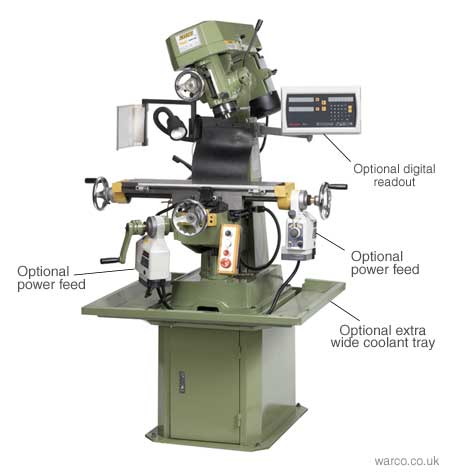Equipment/WarcoMill
Class Red equipment: Do not use without specific training.
(More about equipment classes)
Contents
Summary
(This machine has been purchased but not yet installed.)
The Warco mill can be used to machine objects from a wide range of materials. Training is required before members use the equipment because it is easy for users to damage it, and serious injuries, or fatalaties, are possible. The machine has a table 660 x 152mm that can move 37cm in the X direction, 15cm in the Y and 34cm in the Z direction.
Owners
- Roger Smith
- Robert Copcutt
Health and Safety
- Power supply to be disconnected when changing tools.
- All cutting tools to be kept in their holders until they are required.
- Waste material/offcuts to be kept clear of work area.
- Equipment will be checked for defects before each use to minimise the risk of possible electrical faults or fire.
- Carbon Dioxide extinguisher to be available for any electrical fires
- Eye protection to be worn when using the equipment.
Training
Training and induction will start with a tour of the tool introducing all its parts. The following points will be covered.
- Keep hands well away from the spinning parts.
- Make sure there is no loose clothing or hair that can be caught in rotating parts.
- Take care to mount the work securely.
- Swarf has sharp edges so clean it away with a brush.
- Some parts of the machine are very heavy. It is also possible to work on very heavy parts. Loosing control of heavy objects can cause serious injury. Plan work carefully. Using lifting aids if necessary. Ask for assistance if not totally confident of your ability to control the part at all times.
Instructions
Tips & Tricks
Use a conventional milling cut to get the part to approximately the final size. With a conventional cut the cutting surface and the work piece are moved in opposite directions. A climbing cut is where the cutting surface and the work piece are moved in the same direction. It produces a better finish but puts extra strain on the cutting tool. Therefore only use climbing cuts for light finishing cuts to leave a smooth finish.
When drilling, start with a centre drill to make sure that the hole starts exactly centre. It is usually OK to drill to a depth of 3 to 4 diameters in a single pass. After that withdraw the drill ever diameter of cutting depth to clear the swarf. Use cutting fluid beyond a depth of about 2 diameters. Be aware that halving the diameter of a drill reduces its strength 8 fold. Small drills break very easily and broken tools present a hazard. Much much less pressure is needed to drill small diameter holes. Use just enough pressure to create long curly chips. Look up the appropriate rotation speed for the drill. The Warco cannot spin fast enough for drills below about 2mm. For these, use our Sherline Mill.
Maintenance
- Clean away all swarf at the end of a work session with a brush or vacuum. Do not blow or use bare hands because this can cause injury and send chips where they can damage the machine.
